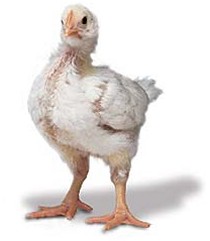Common Questions
Is day old vaccination against Gumboro Disease recommended?
While probably doing no harm the benefits of a day old vaccination are questionable. The level of maternal derived antibody will be too high neutralising the vaccine virus.
See “Vaccination / Decline of MDA in Progeny“.
Despite vaccination we still see Gumboro related mortality. Are we vaccinating too late?
The chances are that vaccination is done to early at a age when maternally derived antibody levels are still high, neutralising the vaccine strain.
See “Vaccination/Vaccination with live IBDV vaccines“.
Is it possible that we have variant strains against which the vaccines do not protect?
All the IBDV strains, including vaccine strains, belong to a single serotype thus all vaccines should be efficacious. Vaccine failure is usually the result of incorrect vaccine administration, or vaccine administration at a time when the maternal derived antibody levels are still too high. By far the majority of Gumboro isolates made outside of North America are classical IBDV.
See “Microbiology/VirusClassification“
Can the Gumboro vaccines be applied by spray administration?
The preferred route of administration is drinking water application as this directs the virus into the digestive tract. However, spray vaccination is an alternative and if administered effectively will give comparable results.
At what age should I vaccinate my chickens against Gumboro disease? I do not have access to a laboratory to determine antibody levels.
Without knowing the antibody levels any decision made on age of vaccination is a gamble. However, some practical guidelines follow to improve the odds.
Commercial broiler or layer chicks originating from parent birds vaccinated with an inactivated gumboro vaccine generally have maternal antibody titers in the range of 1,000 to 8,000 ELISA units. Based on this assumption we can predict that for:
- Broilers
- An intermediate plus vaccine (Nobilis Gumboro 228E) is effective from an age of round 12 days.
- An intermediate vaccine (Nobilis Gumboro D78) is effective from an age of round 18 days.
- Layers
- An intermediate plus vaccine (Nobilis Gumboro 228E) is effective from an age of round 18 days.
- An intermediate vaccine (Nobilis Gumboro D78) is effective from an age of round 28 days.
Further to this it is known that a chicken is protected within 5 – 7 days of successful vaccination with a live gumboro vaccine. (Successful vaccination implies that the vaccine crossed the maternal antibody barrier and entered the bursa.)
A vaccination schedule should thus be designed to give the best possible chance of vaccine take 5 – 7 days before the expected gumboro break. Two vaccinations are recommended with a 5 – 7 day interval between the first and second vaccination.
Examples:
My broiler flock had a spike in mortality due to Gumboro at 21 days of age. At what age should I vaccinate the next flock?
- Symptoms at 21 days. Need to vaccinate at least 5 – 7 days earlier, thus at 14 – 16 days of age.
- At this early age intermediate vaccines (Nobilis Gumboro D78) are not effective in broilers, thus an intermediate plus vaccine (Nobilis Gumboro 228E) is required.
- First intermediate plus vaccination at 12 days of age, second at 17 days of age.
My layer flock had a spike in mortality due to Gumboro at 35 days of age. At what age should I vaccinate the next flock?
- Symptoms at 35 days. Need to vaccinate at least 5 – 7 days earlier, thus at 28 – 30 days of age.
- At this age intermediate vaccines (Nobilis Gumboro D78) are effective in layers.
- First intermediate vaccination at 21 days of age, second at 28 days of age.
For more information see Vaccines.

